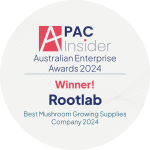Rye or Millet: What’s the Better Grain Choice for Mushroom Cultivation
When producing grain spawn at home, choosing a grain that’s both economical and readily available in your area is the wisest approach. Overthinking this choice isn’t necessary. However, different considerations come into play when buying a pre-sterilized grain bag. Let’s delve into why Millet is often regarded as the gold standard for growing mushrooms when purchasing through a supplier.
Detailed Comparison
Inoculation Efficiency
The number of inoculation points, determined by the individual grains in a given weight, is crucial for effective mushroom cultivation. Hypothetically, if rye has around 3000 kernels per kilogram and millet approximately 8000, millet, being smaller, offers more than double the inoculation points. This significantly enhances colonization efficiency, as more inoculation points allow for more widespread mycelium growth, leading to quicker and more uniform substrate colonization. A dense network of inoculation points in millet fosters a robust mycelial network and reduces competition from other organisms.
Moisture Retention
Millet holds a notable advantage over rye in moisture retention. Post-sterilization, rye begins to lose moisture within 7-10 days, which may not be sufficient for the complete colonization of certain mushroom types. In contrast, millet dries out more slowly, maintaining the essential moisture needed for strong mycelial growth. This aspect is particularly intriguing given that rye actually absorbs more moisture than millet. For instance, to obtain 1 kg of grain ready for use, only 700 grams of rye must be soaked, whereas millet requires 850 grams to achieve the same weight.
Millet’s superior moisture retention makes it also particularly suitable for agar inoculation, where additional moisture isn’t introduced like in liquid cultures or spores.
It is important to know, though, that when you prepare your own Rye grains at home in glass jars instead of mushroom grow bags, the moisture loss is considerably slower, and Rye would be the preferred grain as opposed to millet in this scenario.
Resistance
The structural integrity of grains significantly influences their contamination susceptibility. Rye’s preparation process, which includes additional boiling before sterilization, makes its grains plump and potentially weakens the outer shell. Over-sterilization or rough handling during shipping can break or smudge the outer shell, exposing the susceptible inner core and increasing contamination risk. Millet, not requiring this extra boiling step, maintains its structural integrity better during sterilization. Its harder, unhulled shell is less prone to damage, thus reducing contamination likelihood. This difference in grain preparation and structural resilience is a key reason millet is preferred to mitigate contamination risks.
Contamination Visibility
Millets are light yellow in color; hence, it’s easier to spot Trichoderma and black, pink, and grey molds on millet, though detecting bacterial and yeast contamination may require a keen sense of smell.
Ryes is a darker brownish shade, and it’s much harder to see the contamination.
Nutritional Content
The high nutritional content of rye can be a significant advantage, particularly when used with substrates that are low in nutrients, such as cococoir and vermiculite. This nutrient richness can help support and enhance mushroom growth in these otherwise nutrient-deficient environments.
Another aspect to consider is the impact of rye’s preparation process on its nutritional value; as discussed earlier, rye typically undergoes a two-step cooking process – boiling for hydration followed by sterilization. This double cooking can lead to a significant loss of nutritional content, reducing some of the advantages provided by its inherent nutrient richness.
In contrast, millet, which requires soaking but not boiling before sterilization, better preserves its nutritional content.
Furthermore, when considering the weight-to-volume ratio, 700 grams of rye and 850 grams of millet both swell up to approximately 1 kg after soaking. This indicates that millet offers more actual grain weight in the same volume, providing a denser nutrient and inoculation base. The fact that millet doesn’t undergo the same level of processing as rye also means it retains more of its original nutritional value, making it a more efficient choice in terms of nutrient preservation and overall effectiveness for mushroom cultivation.
Availability of Organic Options
The availability and organic status of rye and millet offer a striking contrast in their cultivation and preparation methods. Rye stands out for its readily available organic options, catering to those committed to organic farming practices, while millet, though popular, faces a scarcity of organic choices, posing a challenge for strict organic cultivators and consumers. The treatment of these grains further accentuates their differences. Millet, typically with lower moisture content in the kernel, do not require fungicides or preservatives, as evidenced by the clear water during washing before sterilizing. On the other hand, despite its organic status, organic rye often contains organic preservatives to prevent mold due to its higher moisture content. This necessitates extensive washing, often up to 5-6 times, to eliminate all preservatives. The moisture content is a crucial factor in this context; while millet’s lower moisture content reduces the need for additives, rye’s higher moisture makes it more susceptible to spoilage, thus needing preservatives, even organic ones, to maintain its quality and safety. This contrast highlights the varying considerations and practices in cultivating and preparing these two grains.
Millet and rye each offer unique benefits, but millet typically stands out as the preferred choice for beginners due to its moisture retention, ease of use, and lower contamination risks. Although rye is nutritionally beneficial, its practical challenges in cultivation make millet a more favorable option for most. This is why it is not hard to see why we supply all commercial mushroom farms with spawn prepared on millet.
Table of Contents
How useful was this post?
Click on a star to rate it!
Average rating 5 / 5. Vote count: 5
No votes so far! Be the first to rate this post.
Get Exclusive Updates - Subscribe Now!
Join our community and stay in the know! Subscribe to our newsletter for exclusive insights, first access to new content, special offers, and industry trends. Don’t miss out—sign up today!
Owner of Rootlab




